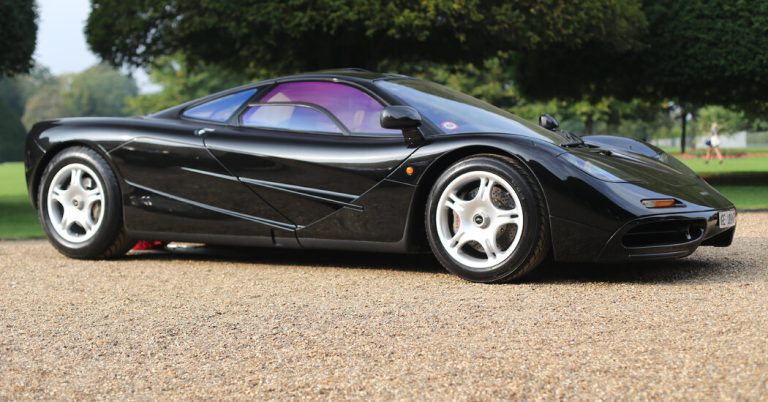The news shocked the collector car world. In May 2022, a 1955 Mercedes-Benz 300 SLR Uhlenhaut Coupé — named after its creator, the company’s chief engineer Rudolf Uhlenhaut — sold for 135 million euros, (about $143 million). That was more than double the previous record of $70 million set by a 1963 Ferrari 250 GTO in 2018.
Perhaps even more amazing is that a car built in the mid-1990s, a McLaren F1, sold in 2021 for over $20 million. Sales in the tens of millions of dollars are rare in the collector car market, but these three cars represent what high-end collectors call “holy grail” cars, so named because they are the most sought after in the vintage car world.
Before the McLaren F1 was sold, the most fertile period for the most expensive post-war collector cars was the 10 years from the early 1950s and early 1960s, which included Mercedes and Ferrari and rivals such as the Jaguar XKSS ( actor Steve McQueen had one), with an example selling in 2023 for $13.2 million.
The McLaren F1, which was built in the 1990s, is a modern car and clearly extreme, and in the quarter of a century since it went out of production, no other road-legal car has appeared as attractive to collectors. Given the seemingly finite life of the internal combustion engine, the McLaren may be the last of the holy grail cars.
Cars that can sell for eight and nine figures have a lot in common, some are obvious even to people who don’t own cars, and some are slightly more nuanced. Rarity is an important factor. The Mercedes was one of two built. Ferrari produced two series of 250 GTOs totaling 36 cars. Only 16 of the Jaguar XKSS were built before a factory fire ended production. and in McLaren’s case 106 were built.
All four cars are generally regarded as design triumphs.
“With one exception, F1, all are real or slightly modified racing cars, a class that by its very genesis means very limited production, very high performance, seductive styling without compromises meant to deceive the wind, the very image it shudders,” Miles Collier, author of “The Archaeological Automobile,” said in June. “And, of course, these cars are astronomically valuable in today’s market, reflecting the importance collectors place on these machines.”
Brian Rabold, vice president of automotive for Hagerty, the classic car insurance and auto entertainment brand, said the appeal of these holy grail cars was worldwide.
“They are isolated from trends, they are the very definition of car connoisseurs,” he said.
Nathan Merz, a vintage car dealer near Seattle, said owning just one of these cars probably represented the ultimate purchase for most collectors.
“Once you add something like a Ferrari 250 GTO to a collection, where do you go from there?” he said. “Holy Grail cars represent once-in-a-lifetime opportunities, the culmination of a long-term search for the biggest and best.”
Mr Collier said Mercedes, Ferrari and Jaguar, all built for racing, could still operate in normal road traffic. “And, they’re not so fast that they can’t be driven hard by a normal, skilled driver,” he said.
Owners of these top cars can and do use them, and this usability contributes to their desirability. There are events specifically tailored to these types of cars, such as the Goodwood Festival of Speed in England, which starts on Thursday, and the Le Mans Classic in France, which ended on Saturday, where the cars can be driven close to their potential, said Mr. Rumbold.
Neither Mr Collier nor Mr Rabold said they believed modern high-performance cars had much in common with Mercedes, Ferrari, Jaguar and McLaren.
“Cars like the Bugatti Chiron can have twice the horsepower [almost 1,600] of the McLaren F1 and many times more than a vintage Ferrari, Mercedes or Jaguar, but that doesn’t necessarily make them better than their analog predecessors, nor is a car like the Bugatti directly related to any competitive racing car,” said Mr Rabold.
Mr Collier said “modern supercars have capabilities that often exceed the skills of the owner and have equally intractable repair issues that send them to the scrap heap with all those smartphones, laptops and digital devices.”
“In this modern world, our four candidates are hand-made,” he said. Their plans were drawn up on paper, which has been preserved and can be repaired “as long as there are craftsmen”.
Easy repair was part of the McLaren F1 ethos.
“While the car was two full generations younger than Mercedes, Jaguar and Ferrari and starting to enter the modern era, the McLaren was deliberately designed with restoration in mind,” Mr Collier said.
And while it wasn’t specifically designed as a racing car, a modified F1 version won the 24 Hours of Le Mans in 1995. And it wasn’t just a class win, the car took the overall race.
Mr Collier said the win cemented F1’s reputation as the holy grail single-seater. “It is the only road car in living memory to win the 24 Hours of Le Mans.”
Aston Martin is looking to match that feat by announcing that it will enter Le Mans in 2025 with a competition version of its street-legal Valkyrie hyper car. Regardless of this car’s success in France, with its sophisticated, electronically-laden hybrid powertrain, it’s a far cry from the analogue honesty of the McLaren F1.
“The Valkyrie has many attributes working in its favour, namely: rarity, strong Aston Martin brand recognition, world-class performance and a highly touted design team,” said Mr Rabold. “But it’s too early to write his legacy.”




